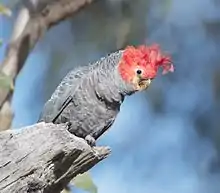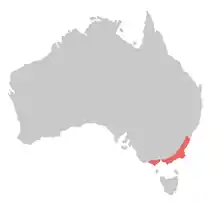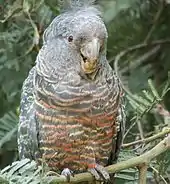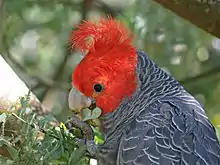Gang-gang cockatoo
The gang-gang cockatoo (Callocephalon fimbriatum) is found in the cooler and wetter forests and woodlands of Australia, particularly alpine bushland. Mostly mild grey in colour with some lighter scalloping (more pronounced and buffy in females), the male has a red head and crest, while the female has a small fluffy grey crest. It ranges throughout south-eastern Australia. The gang-gang cockatoo is the faunal emblem of the Australian Capital Territory. It is easily identified by its distinctive call, which is described as resembling a creaky gate, or the sound of a cork being pulled from a wine bottle.
| Gang-gang cockatoo | |
|---|---|
 | |
| Adult male in the Australian Capital Territory | |
| Scientific classification | |
| Kingdom: | Animalia |
| Phylum: | Chordata |
| Class: | Aves |
| Order: | Psittaciformes |
| Family: | Cacatuidae |
| Genus: | Callocephalon Lesson, 1837 |
| Species: | C. fimbriatum |
| Binomial name | |
| Callocephalon fimbriatum (Grant, 1803) | |
 | |
| Range of C. fimbriatum | |
The name gang-gang comes from a New South Wales Aboriginal language, probably from one of the coastal languages, although possibly from Wiradjuri. It is probably an onomatopoeic name.[2]
Description
The gang-gang cockatoo is a grey bird with a wispy crest. The head and crest is bright red in males, but dark grey in females. The edges of feathers in underparts have edges of yellow or pink. The edges of feathers on upperarts are slightly paler grey than the rest of the feather, which makes the bird look somewhat barred. Juvenile males can be distinguished by their brighter crowns and shorter crests, but otherwise look similar to the adult female. The birds are not easily mistaken for other cockatoos, but while in flight may resemble the Galah. Gang-gangs are very social birds, but not overly noisy.[3]
Taxonomy and systematics
The gang-gang cockatoo was most often allied with the white cockatoos of the genus Cacatua. This has always been controversial due to the unusual appearance and coloration of the bird, especially its sexual dichromatism. New research has finally resolved the matter, with the gang-gang cockatoo being recognized as a distinctive early offshoot of the calyptorhynchine (dark) cockatoos.[4] Considering the robust phylogeny of the cockatoos now established, a comparison of characteristics gained and lost during the evolution of cockatoos suggests that the gang-gang cockatoo—while of course much changed and adapted during the perhaps 20 million years since its last common ancestor with any other living species lived—is probably still very similar in overall appearance to how the earliest cockatoos would have looked, and certainly the most primitive-looking of the species alive today.
Distribution and habitat
The gang-gang is endemic to coastal regions of south-eastern Australia. They used to inhabit King Island off of Tasmania, but they have since gone extinct locally. They are an introduced species on Kangaroo Island. The gang-gang prefers forests and woodlands in the mountains with dense shrub understories. The birds migrate short distances during winter into more open habitats. However they must migrate back to denser forests to breed, as they need tall trees in order to build nests.[3]
Ecology
Status
Loss of older, hollow trees and loss of feeding habitat across south-eastern Australia through land clearing has led to a significant reduction in the numbers of this cockatoo in recent years. As a result, the gang-gang is now listed as vulnerable in New South Wales.[5] It is protected as a vulnerable species under the Biodiversity Conservation Act 2016 (NSW).[6] This protection status as a threatened species makes it a Tier 1 criminal offence for a person or corporation to knowingly damage the bird's habitat.[7] Damage is defined to include "damage caused by removing any part of the habitat".[8] Habitat is defined to include "an area periodically or occasionally occupied by a species".[9]
Gallery
 A female gang-gang cockatoo eating peppercorns
A female gang-gang cockatoo eating peppercorns Female
Female_-Blue_Mountains-8.jpg.webp) Male in the Blue Mountains
Male in the Blue Mountains Male eating Acacia baileyana seeds
Male eating Acacia baileyana seeds_-NSW_-Australia-8.jpg.webp) Two immature birds at New Buildings, NSW, Australia: The male is on the left and the female on the right.
Two immature birds at New Buildings, NSW, Australia: The male is on the left and the female on the right.
References
- BirdLife International (2018). "Callocephalon fimbriatum". IUCN Red List of Threatened Species. 2018: e.T22684755A131914594. doi:10.2305/IUCN.UK.2018-2.RLTS.T22684755A131914594.en.
- Gray, Jeannie; Fraser, Ian (2013). Australian Bird Names: A Complete Guide. Collingwood, VIC, Australia: CSIRO Publishing. p. 127. ISBN 9780643104709.
- "Gang-gang Cockatoo | BIRDS in BACKYARDS". www.birdsinbackyards.net. Retrieved 2019-06-14.
- Brown, D.M.; Toft, C.A. (1999). "Molecular systematics and biogeography of the cockatoos (Psittaciformes: Cacatuidae)". Auk. 116 (1): 141–157. doi:10.2307/4089461. JSTOR 4089461.
- Hughes, Lesley (2005). "Gang-gang Cockatoo - vulnerable species listing". NSW Scientific Committee - final determination. New South Wales Office of Environment & Heritage. Retrieved 21 November 2011.
- Biodiversity Conservation Act 2016 (NSW), Schedule 1: Part 3 Vulnerable species
- Biodiversity Conservation Act 2016 (NSW), s.2.4
- Biodiversity Conservation Act 2016 (NSW), s.1.6
- Biodiversity Conservation Act 2016 (NSW), s.1.6
- Flegg, Jim (2002). Photographic Field Guide: Birds of Australia. Sydney & London: Reed New Holland. ISBN 1-876334-78-9.
External links
| Wikimedia Commons has media related to Callocephalon fimbriatum. |
| Wikispecies has information related to Callocephalon fimbriatum. |
| Look up Gang-gang cockatoo in Wiktionary, the free dictionary. |
- Gang-gang Cockatoo Species Profile at World Parrot Trust Parrot Encyclopedia
- BirdLife species factsheet for Callocephalon fimbriatum
- Gang-gang cockatoo on the Atlas of Living Australia
- "Callocephalon fimbriatum". Avibase.

- "Gang-gang cockatoo media". Internet Bird Collection.
- Gang-gang cockatoo photo gallery at VIREO (Drexel University)
- Interactive range map of Callocephalon fimbriatum at IUCN Red List maps
- Audio recordings of Gang-gang cockatoo on Xeno-canto.

